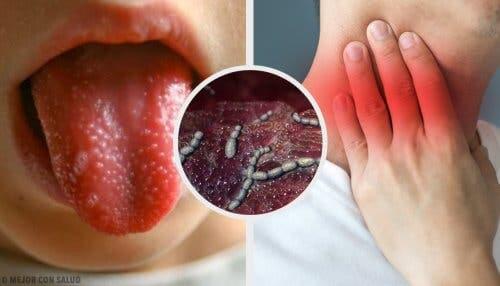Scarlet Fever in Children: Symptoms and Treatments

Have you ever heard of scarlet fever? It’s an eruptive disease that usually affects children between 5 and 15 years old. If you want to know its symptoms, treatments, and how it spreads, keep reading!
Scarlet fever in children

Scarlet fever is a bacterial infection caused by group A streptococci. In fact, this is the bacteria that also causes strep throat and skin infections. In the case of scarlet fever, these bacteria start to produce a toxin that causes the red rash that gives this disease its name.
Check this out: What Are the Kinds of Bacteria in Your Mouth?
How does scarlet fever spread?
Like other bacteria, strep spreads through droplets of saliva or mucus that an infected person expels by coughing or sneezing. When a person comes in contact with these liquids and touches their nose, mouth or eyes, they transfer the bacteria to their own body.
On the other hand, it’s also possible to get scarlet fever by coming in contact with streptococci skin sores. If your child has this condition, wash your hands well after helping them put on cream to fight the itching.
Symptoms in children

The symptoms of scarlet fever in children are similar to other rashes. However, some characteristics are different, which helps pediatricians diagnose the disease. Here are some of the main symptoms:
- A reddish rash that appears on the face and neck area, without affecting the mouth, and that slowly spreads to the armpits, chest, and groin until it covers the entire body. Then, the red spots start to bulge, and they feel rough like sandpaper.
- Fever higher than 100ºF.
- Sore throat, which makes it hard to swallow. Also, the tonsils might be inflamed.
- Sometimes the tongue is swollen. In addition, it may have a white coating, then becomes reddish and has small bumps.
- Shaking chills.
- Vomiting and abdominal pain.
If your child has several of these symptoms, don’t hesitate to go to the doctor. You should treat scarlet fever with antibiotics since it’s a bacterial disease. Also, your pediatrician will surely confirm the diagnosis by performing a strep test or throat culture.
Don’t miss out: Tips that May Help to Reduce a Fever Naturally
Treating scarlet fever in children

As we’ve already mentioned, bacteria causes scarlet fever. For this reason, it’s important to take antibiotics to fight the infection. Antibiotics are usually prescribed orally. However, if the child refuses to take the medication, the doctor might prescribe injections.
As for the fever, the treatment is the same as with any other disease: give your child acetaminophen or ibuprofen, according to what your doctor recommends. That way, you can control your child’s discomfort and fever.
Don’t give your child aspirin, as this could cause side effects.
Remember to monitor how much water your child drinks. In fact, it’s very important to drink enough fluids to avoid dehydration. Additionally, here are some other things you can do to help alleviate your little one’s discomfort:
- Prepare easy-to-eat foods. For example, make soups, purees, small noodles or boiled vegetables.
- Give your child freshly squeezed juices.
- Offer your child drinks to help decrease the inflammation in their throat.
- Prepare smoothies or milkshakes with milk and fruits- nutritious, fresh and tasty!
- Apply some cream to relieve itching on your child’s skin.
- Oatmeal can be another way to relieve itching. You should mix a little in the bath water and let your child relax there.
- Cut your child’s nails to prevent them from scratching.
If after 48 hours your child still has a fever, upset stomach, vomiting, or open skin wounds, call your doctor. The specialist will want to check to make sure everything is moving along as it should.
All cited sources were thoroughly reviewed by our team to ensure their quality, reliability, currency, and validity. The bibliography of this article was considered reliable and of academic or scientific accuracy.
- MedlinePlus staff. (n.d.). Infecciones por estreptococo. MedlinePlus. https://medlineplus.gov/spanish/streptococcalinfections.html
- Centers for Disease Control and Prevention. (n.d.). Escarlatina: lo que debe saber. CDC.
https://www.cdc.gov/groupastrep/diseases-public/scarlet-fever-sp.html - KidsHealth staff. (n.d.). Escarlatina. KidsHealth. https://kidshealth.org/es/parents/scarlet-fever-esp.html?WT.ac=pairedLink
- Martínez, C. C., Suárez-Varela, M. M., Durántez, M. S., Reigada, M. C. O., Tamarit, D. P., & Botet, F. A. (2001). Estudio epidemiológico de un brote de escarlatina. Revista Pediatría de Atención Primaria, 3(9), 41-50. http://archivos.pap.es/files/1116-139-pdf/143.pdf
This text is provided for informational purposes only and does not replace consultation with a professional. If in doubt, consult your specialist.








